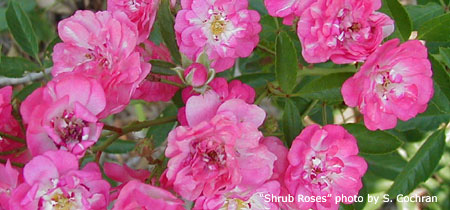Sarah Browning, Nebraska Extension Educator

Shrub Roses by S. Cochran
There are several things you can do to help your roses survive this winter, and the first is to make sure your roses are healthy and not under stress as they go into winter. Strong plants have a better chance of surviving well than weak plants. The most important thing you can do to reduce stress is continue to water roses until the ground freezes, even if they are dormant. Soak plants to a depth of 8-12 inches, every 2-3 weeks.
Winter Clean-up
Begin by removing fallen leaves and other debris from around each plant. Removing all of the old leaves is very important, especially if disease problems occurred during the summer. Leaves serve as a good source of overwintering fungal spores that can re-infect your plants next year.
Prune out any broken, damaged or diseased canes. If the plant is tall, loosely tie the remaining canes together with twine to prevent damage from strong winds.
Winter Mulch
Next, plan to provide some extra winter protection for hybrid tea and climbing roses. Often gardeners put winter protection, such as extra mulch or rose cones, in place too early in fall. Subconsciously we may think that the goal is to keep the plants warm, but this can backfire on us. Extra mulch applied too early prevents the soil around rose roots from cooling down as it should, which in turn allows rose growth to continue, when they should be going dormant. The goal of winter mulch is to keep rose roots cold, so it's important to let the soil cool down before mulch is applied. Winter mulch also helps prevent soil temperature fluctuations during winter.
Winter hardy shrub roses, such as the Knock Out or Buck rose series, don't usually need extra protection. So if you prefer to create a low maintenance garden, plant some of these roses next year and you won't need to apply extra winter mulch or rose cones.
If you do need to apply winter mulch the time to apply is after 2-3 hard freezes, and after all the roses leaves have fallen. Research has shown that coarse materials such as wood shavings, chopped corn cobs, dry leaves and grass clippings, wood chips, loose compost, chopped hay or coarse sawdust provide small air spaces for insulating air, and insulate the crown of the bush best. Even better than styrofoam cones. Manure and topsoil don't perform as well, because of their fine texture. Fine materials restrict air penetration, and hold excessive moisture, from rain or melting snow, around the plant crown.
Hill or mound mulch around the base of plants to protect hybrid teas, floribunda, and grandiflora roses. Create the mound around the base of the plants about 8-10 inches tall. Place a light layer of top soil over the mound, if a coarse material is used, to prevent mulch loss due to strong winter winds.
If a styrofoam rose cone is used, prune the bushes as needed to allow the cones to be place over the plants, and at the same time remove any broken, damaged or disease canes. Mound 6-8 inches of soil up around the base of each plant since the cone alone won't provide adequate winter protection. Then place a cone over each rose, securing it with heavy objects. Make small holes or slits in the top of the cone to provide ventilation.
Climbing Roses
Winter protection for climbing roses is imperative as most bloom on the previous year's growth. One method of protection is to attach a sturdy pole to a fence or trellis above the climbers crown. Untie the canes from the fence or trellis and retie them securely to the pole. Wrap the canes in burlap and stuff the whole thing full of straw. This will insulate the plant somewhat from temperature extremes and protect it from drying winter winds. Again, protect the base of the plant by creating a mound with wood chips, covered by a light layer of soil.
Another method is to remove the canes from the trellis and bury them in a shallow trench, followed by a covering of 3-4 inches of soil. After the soil freezes, clean mulch may be added. This will keep the sun from thawing the soil too early in the spring.
And remember that plants need watering during dry winters, especially in December, January and February, when the soil is not frozen. This is especially important for new plantings that were installed in fall, and haven't had much time for root development.
Search Our Archive
Associated Video
Shrub Rose Clean Up
Corey Brabec from Earl May Nursery and Gardens shows us a simple way to trim shrub roses back so they can perform bette